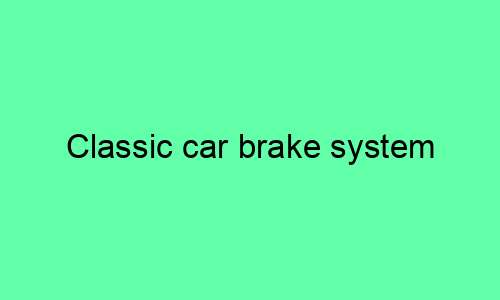Classic Car Brake System
Introduction
The brake system is one of the most important safety features on any car, and classic cars are no exception. However, the brake systems on classic cars are often quite different from those on modern cars, and it is important to understand these differences in order to maintain and repair them properly.
Types of Brake Systems
There are two main types of brake systems used on classic cars: drum brakes and disc brakes. Drum brakes are the older type of brake system, and they use a set of brake shoes to press against the inside of a rotating drum. Disc brakes are a more modern type of brake system, and they use a set of brake pads to press against a rotating disc.
Drum brakes are less effective than disc brakes, but they are also less expensive. Disc brakes are more effective, but they are also more expensive. The type of brake system that is best for a particular car will depend on a number of factors, including the car’s weight, speed, and intended use.
Brake Components
A typical brake system consists of the following components:
- Brake pedal: The brake pedal is used to apply pressure to the brake system.
- Master cylinder: The master cylinder is used to convert the force applied to the brake pedal into hydraulic pressure.
- Brake lines: The brake lines are used to carry the hydraulic pressure from the master cylinder to the wheel cylinders or calipers.
- Wheel cylinders or calipers: The wheel cylinders or calipers are used to convert the hydraulic pressure into mechanical force, which is then used to apply the brake shoes or pads to the drums or discs.
- Brake shoes or pads: The brake shoes or pads are the friction material that is used to stop the car.
Brake System Maintenance
It is important to regularly maintain the brake system on a classic car in order to ensure that it is functioning properly. Some of the most common brake maintenance tasks include:
- Checking the brake fluid level: The brake fluid level should be checked regularly and topped off as needed.
- Inspecting the brake pads or shoes: The brake pads or shoes should be inspected regularly for wear and tear.
- Replacing the brake fluid: The brake fluid should be replaced every few years.
- Bleeding the brake system: The brake system should be bled whenever any components are replaced.
Brake System Repair
If the brake system on a classic car is not functioning properly, it is important to have it repaired by a qualified mechanic. Some of the most common brake repair tasks include:
- Replacing the brake pads or shoes: The brake pads or shoes should be replaced when they are worn out.
- Replacing the brake lines: The brake lines should be replaced if they are damaged or leaking.
- Replacing the master cylinder: The master cylinder should be replaced if it is leaking or if it is not functioning properly.
- Rebuilding the brake calipers or wheel cylinders: The brake calipers or wheel cylinders should be rebuilt if they are leaking or if they are not functioning properly.
Conclusion
The brake system is one of the most important safety features on any car, and classic cars are no exception. It is important to understand the different types of brake systems and how they work in order to maintain and repair them properly. By following the tips in this article, you can help to ensure that your classic car’s brake system is always functioning properly.






